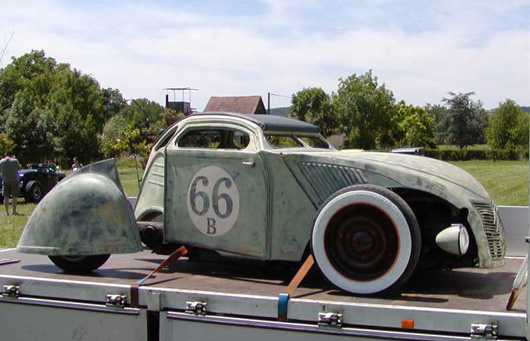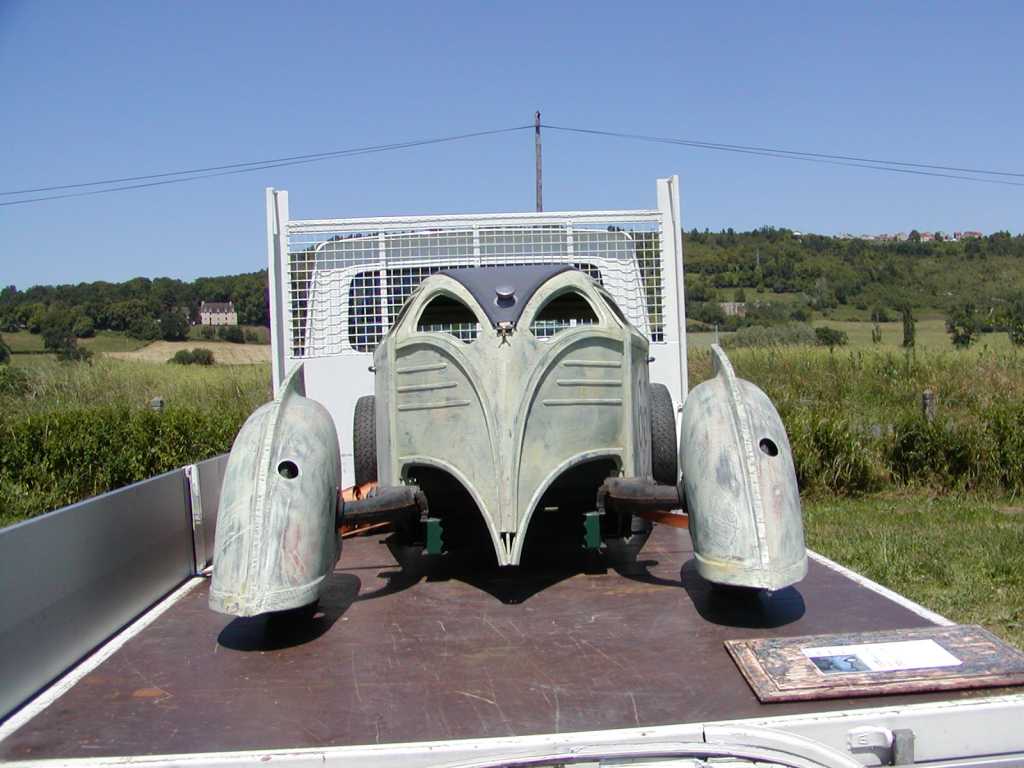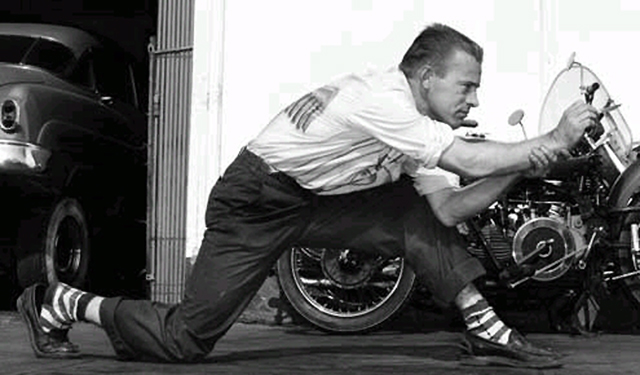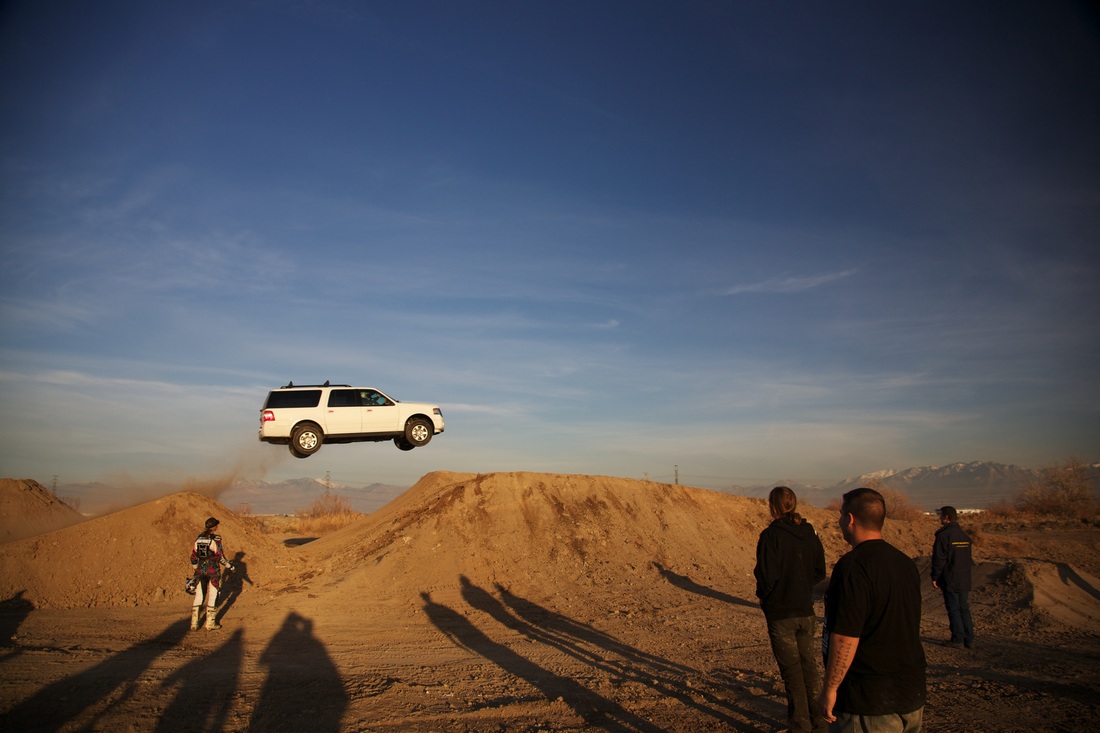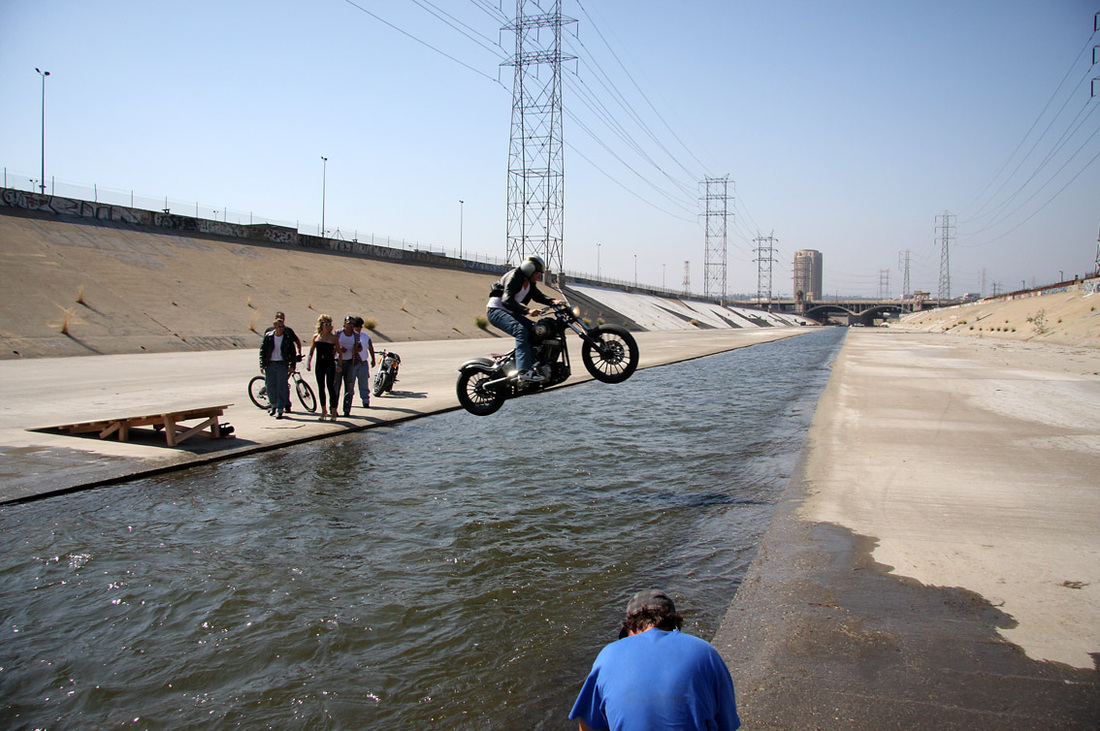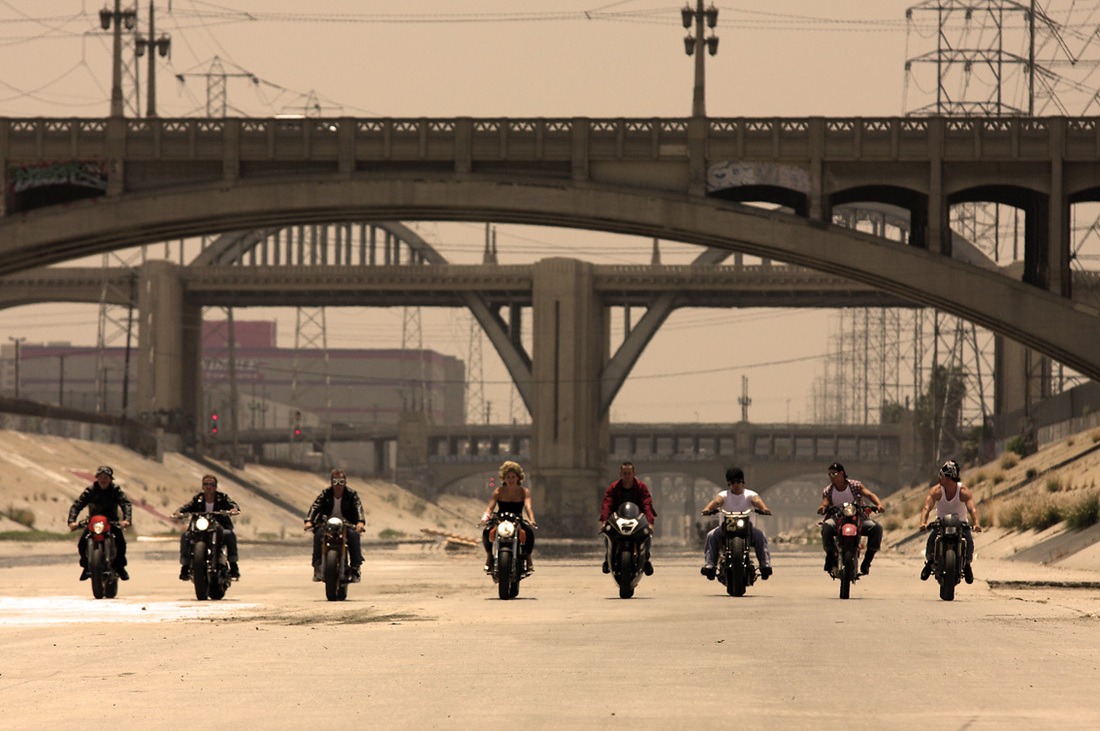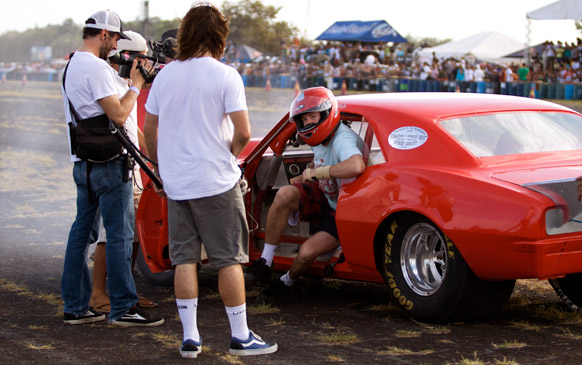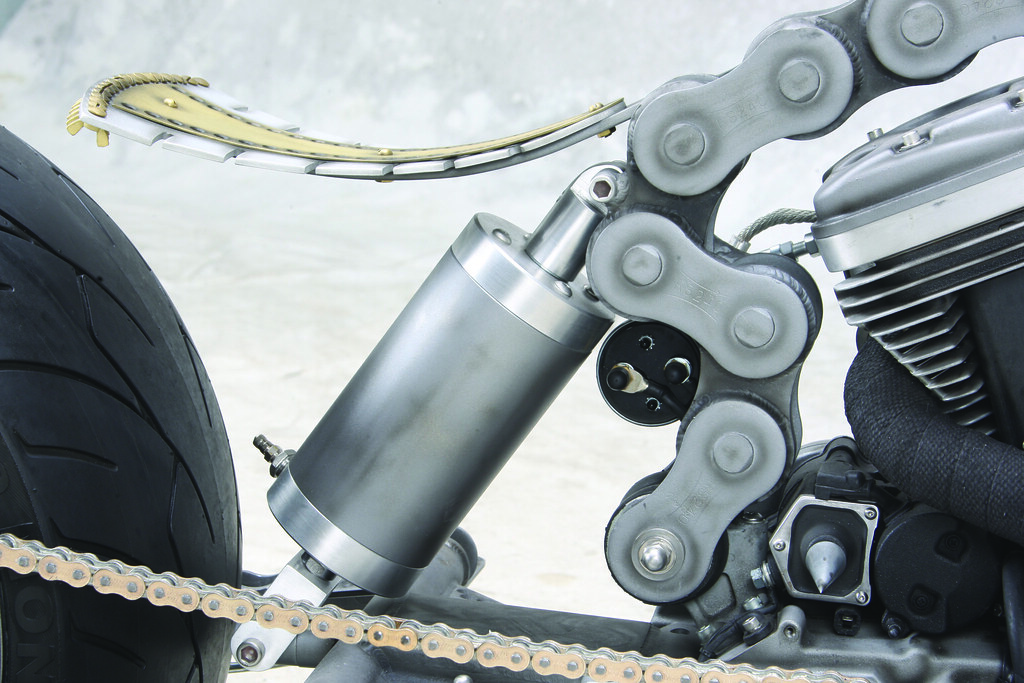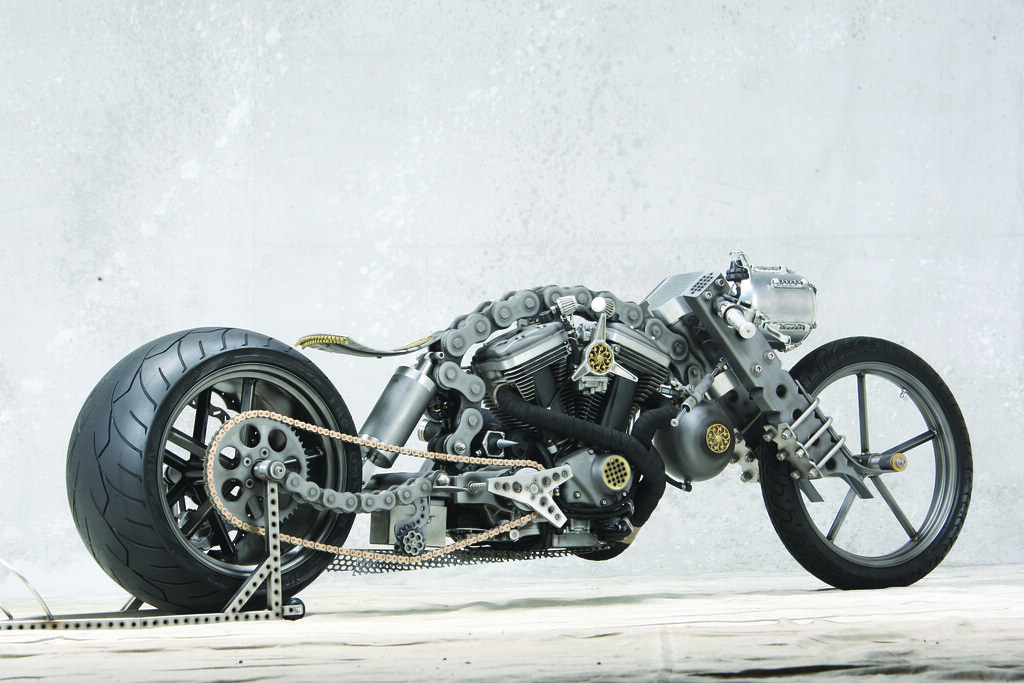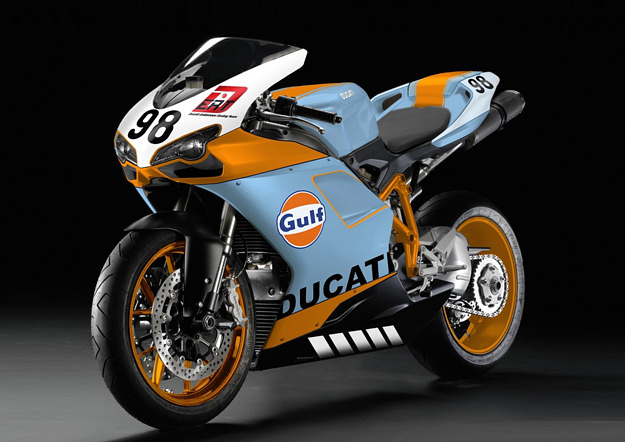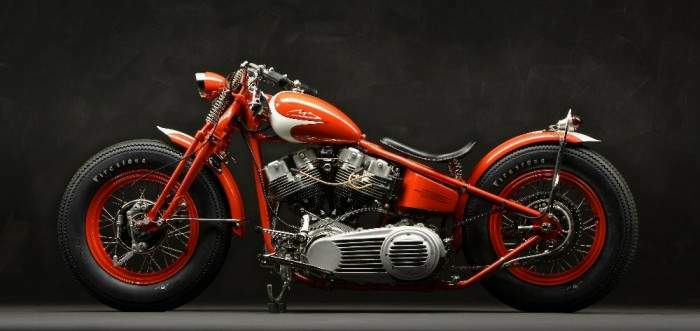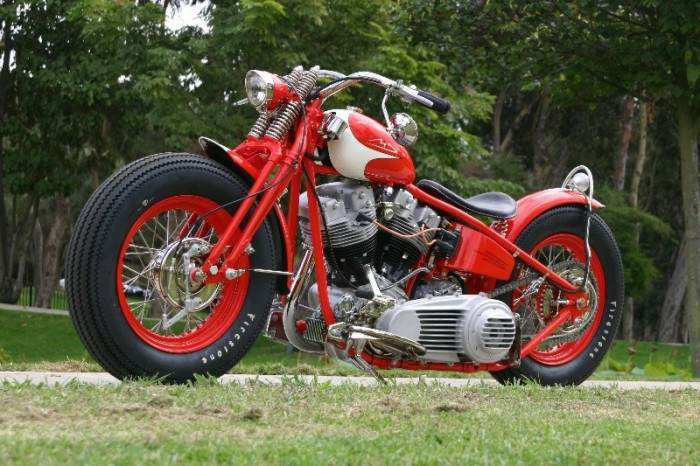Tuesday, June 26, 2012
2012 Shelby Mustang 1000
SHELBY MUSTANG 1000
based on the Shelby Mustang GT 500
Power increased to over 1000 HP!!!
R.I.P. Carroll Shelby
Harley Davidson | 1929 Custom Built Motorcycles Board
Labels:
Bike,
Engine,
Harley,
Harley Davidson,
Jet,
Propulsion
Friday, June 22, 2012
Wonderful Hot Rod - Citroen 2cv
Not what you’d expect in a rat rod at all, but what would kinda naturally flow from what began as a front-drive rattletrap of a car. The Citroen 2CV is pretty rare here in the US, but they’re common as houseflies in Europe, so it makes sense that people mod them into every conceivable form, as evidenced by this video. There are some who go so far as to convert them to four-wheel-drive.
Since the car is front drive, there is no need to do much of anything with the rear wheels, so the builder took the opportunity to emphasize the rear swingarm. While I’ve never seen a 2CV’s rear swingarm, I can only guess that this is an exaggeration of the original; or maybe that’s just its normal size. From what I’ve seen in photos on the net, both the front & rear suspension consists of swingarms attached to torque tubes, utilizing a funky horizontal spring and shock absorber setup for each corner, similar to a VW’s rear end.
Monday, June 18, 2012
Kenneth "Von Dutch" Howard
Labels:
Barris,
Culture,
Custom,
Kenneth Howard,
Kustom Art,
Kustom Kulture,
Motorcycle,
Motorcycles,
Pinstriping,
Von Dutch
Friday, June 15, 2012
Ralph Lauren's 1960 Ferrari GTO
Labels:
1960,
250,
Collection,
Ferrari,
GTO,
Lauren,
Ralph,
Ralph Lauren Ferraro
Almost "Millecavalli" - Suzuki Escudo Pikes Peak (987hp)
Along with its fabulous racing career, it has also stared in the popular video game, Gran Turismo, where it was listed as the Pikes Peak Edition. Suzuki never referred to it using that name.
The Pikes Peak International Hill Climb takes place in Colorado. The course is 12.35 miles long, begins at an elevation of 9,200 feet and finishes at 14,100 feet. There are 156 corners throughout the course.
By Daniel Vaughan | Dec 2007
The Suzuki Sidekick, as it was known in North America, was produced under various names from 1989 through 2003. The Sidekick was known by many names; in Europe it was the Vitara as well as North America after 1999, and the Suzuki Escudo, which was produced from 1989 through 2004. The project was a joint venture between General Motors and Suzuki. GM's version were known as the Geo Tracker, after 1998 they were the Chevrolet Tracker. In Canada they were the Pontiac Sunrunner, in Spain it was the Santana 300 and 350. It even carried a Mazda badge in the Japanese market.
For the North American market, the Suzuki Sidekick was first introduced in 1989. It was offered in two bodystyles including a two-door convertible or hardtop. The JA version was fitted with a 1.3-liter engine. The JX and JLX trim levels had a 1.6-liter engine rated at 80 horsepower and given a four-wheel drive system. The JLX version was removed from the line-up in 1990. A four-door version of the Sidekick was introduced in 1991, sitting on a larger wheelbase, and greatly enhancing the versatility and appeal of the vehicle. A Sport version appeared in 1996, featuring a 1.8-liter engine that was good for 120 horsepower. The package included 16-inch alloy wheels, a two-tone paint scheme, and dual airbags for safety.
1996 was the same year Suzuki introduced their X-90, which was basically a Sidekick with two doors, seating for two, a trunk, removable T-bar roof, and a much rounder body. Mechanically, they were identical. The X-90 never sold well as the public did not agree with the design. Production lasted for a short time, ending in 1998.
In 1999, the Sidekick/Escudo/Vitara was redesigned. For North America, the name 'Sidekick' was dropped in favor of Vitara. The four-seater vehicle could be purchased with a 1.3L, 1.6L, or 1.8L four-cylinder engine with carburetion or electronic fuel injection. Diesel engines were made available in Europe. A four-speed manual was standard, with a five-speed manual and automatic being offered as optional equipment. The Vitara came in two- or four-door models or soft-top 2-door models.
The Vitara remained in production in North America until 2003. Its twin, the Chevrolet Tracker, follwed the same fortune the following year.
Thursday, June 14, 2012
Andy Bell Stunt Reel 2011 and Pictures
More about ANDY BELL
Height: 6'1"
Weight: 195 lbs
Born Penticton, BC, Canada
Resides in Long Beach, CA
Andy was born to be a stunt man from day one. He started walking at age 8 months, running at 9 months and was downhill skiing unassisted at 16 months.
A natural born showoff with a knack for sports, Andy mastered horseback riding, skiing, swimming, SCUBA Diving, kickboxing, motorcycle riding and all other things that involved adrenaline with ease. He quickly became certified as a Life Guard, Ski Instructor, Horse Wrangler, SCUBA Diver and First Aid attendant while pursuing his passion of becoming a professional Motocross racer. Through his career in both Professional Motocross Racing and Freestyle Andy racked up championships around the globe, culminating in earning 9 Guinness Book World Records in a single day in 2009.
Previous
Stunts
Holder of 9
Guinness Book World Records
Longest car
drift (4137 feet)
Longest
nose manual on a motorcycle (dirt bike) (188 feet)
Longest
motorcycle jump with 3 people
Most people
motorcycle ramp jump
Longest
tandem ATV wheelie
Longest
three person ATV wheelie
Longest UTV
(rhino) wheelie (960 feet)
Longest UTV
(rhino) jump
Fastest
speed in a towed trash can
FILM
Mercenary
for "Last Stand"
2013
Coordinator:
Wade Allen
Motorcycle
jump for Jackass 3D 2010
Coordinator:
Charles Grisham
Motorcycle
tow in for Jackass 3D
2010
Coordinator:
Charles Grisham
High fall
to blob for Jackass 3D
2010
Coordinator:
Charles Grisham
Utility
Stunts for Jackass 3D
2010
Coordinator:
Charles Grisham
TELEVISION
Motorcycle
stunts/riding/wheelies for Time Warner "Enjoy Better" Superbowl
commercial (1 of 2) 2012
Coordinator:
Sean Graham
Motorcycle
stunts/riding/wheelies for Time Warner "Enjoy Better" ESPN commercial
(2 of 2) 2012 Coordinator: Sean Graham
"Whipped"
jump builder for car stunts
2012
Coordinator:
Alex Daniels
Fight Scene
w/ Jason Ellis for “The Daily Habit” Fuel TV 2011
Coordinator:
Andy Bell
Parkour
(Freerunning) stunts for “Ultimate Parkour Challenge” (MTV) (also was the Host) 2010
Coordinator:
Paul “Diddy” Darnell
Harley
Stunt for “The Dudesons in America” (MTV)
2010
Coordinator:
Chris O’Hara
Dirt bike
stunts (wheelies, car chase) for “Nitro Circus” (episode: Hollywood Nitro) 2009
Coordinator:
Scott Rogers
Dirt bike
jumps / FMX “Nitro Circus” (episode: LA Nitro)
2009
Coordinator:
Monte Perlin
Big wheel
flips/stunts for Nitro Circus
2009
Coordinator:
Andy Bell
Waterski
stunts (big waves and pyramid) for “Nitro Circus” (episode: Aqua Circus) 2009
Coordinator:
Andy Bell
Downhill
skiing (flips and stunts) for “Nitro Circus” (episode: Winter Wonderland) 2009
Coordinator:
Andy Bell
Boxing
stunts for “Nitro Circus” w Miguel Cotto
(episode: Puerto Rico)
2009
Coordinator:
Andy Bell
Bull riding
for “Nitro Circus” (episode: The Circus Heads West) 2009
Coordinator:
Gary Leffew
LA River
Harley jump (hardtail Harley over LA River) for “Nitro Circus” (episode: LA
Nitro) 2009
Coordinator:
Andy Bell
Tandem
backflip streetbike w/Travis Pastrana for “Nitro Circus” (episode: Hell
Compound) 2009
Coordinator: Andy Bell / Travis Pastrana
Helicopter
jump to lake for “Nitro Circus” (episode: Lake Medina)
2009
Coordinator:
Andy Bell
100 ft
Suburban jump for “Nitro Circus” (episode: Mud and Guts)
2008
Coordinator:
Dennis Anderson
NASCAR
stunt driving (race and drift) for “Nitro Circus” (episode: Southern
Discomfort) 2008
Coordinator:
Andy Bell / Travis Pastrana
Sea Doo
Stunts (riding up class 5 rapids) for “Nitro Circus” (episode: Southern
Discomfort) 2008
Fire Stunt
/ Exploding car for “Nitro Circus” (episode: Southern Discomfort) 2008
Coordinator:
Dr. Danger
Live Shows
Nitro
Circus Live (The Tour)
2010/2011
Big wheel
backflips on the Mega Ramp
World
Record UTV (Rhino) jumps
BMX flips
on mega ramp
Stunt
Coordinator Experience
All of my
own stunts for Nitro were set up and coordinated by myself (other than listed
otherwise)
MX/FMX/Truck
and Monster Truck crossover for Nitro Circus 2008
Multiple
FMX and BMX stunt shows
2001-2011
Stunt
References
Charley
Grisham
Johnny
Knoxville, EP “Jackass 3D”
Travis Pastrana, EP “Nitro Circus”
More Elizabeth Raab's Pictures
Warm, bright, and girly Elizabeth Raab is not a spoiled princess enamored with the idea of riding on the back of someone else’s bike. Her passion is the same that has caused the creation of countless man caves. Raab's images are simple and complicated, precise and unwieldy, grimy and pristine. Paradoxical by nature, they contain a sensuality that allows both human and inanimate subjects to blur the boundaries between still life and portraiture. Realism and objectivity yield to uniquely vivid color palettes combined with a detached sense of forlorn beauty and intriguing silence that permeate her scenes. Raab has been featured in exhibitions and publications across the US and Europe, hails from the Pacific Northwest and now resides in New York with her husband and two children.
ELIZABETH RAAB:
elizabeth@elizabethraab.com
1 917.374.9472
New York, NY
DUCATI ART:
www.ducatiart.com
41 22.901.65.52
Geneva, Switzerland
Labels:
Art,
Bultaco,
Elizabeth,
Elizabeth Raab,
Guerriere,
Harley Davidson,
Lifestyle,
Photography
Wednesday, June 13, 2012
Hells Angels On Wheels
Labels:
60s,
70s,
Barger,
Chopper,
Choppers,
Custom,
Hell's Angels,
Jack,
Motorcycle,
Motorcycles,
Movie,
Nicholson,
Sonny,
Vintage
RK Concepts - The Missing Link
2009 World Championship
RK Chain by Rafik Kaissi, RK Concepts
Buell 1200cc Engine
360mm rear wheel
www.rkconcepts.com
Labels:
1200,
360mm wheel,
Buell,
Chain Frame,
Concept,
Motorcycle,
RK Concepts
Gulf - Ducati 1098R - Real and 3DsMax
It’s strange to see a Ducati in anything other than red. But the lines of the 1098R suit the most iconic racing colors of all: the blue and orange of Gulf Oil. This French-entered bike ran competitively in the 2008 Le Mans 24 Heures Moto, before gearbox troubles forced it out. Not quite as successful as the legendary Ford GT40s of 1968, 1968 and 1975 then, but the livery is so evocative we can forgive that. For the designers amongst you, the Gulf colors are Pantone Blue PMS 301 and Pantone Orange PMS 165.
This work is based on a rather well known real-world customized Ducati 1098. Other schemes and renders will follow
Created in 3D Studio MAX, V-Ray used for materials and rendering. Textures created in CorelDRAW and Photoshop.
Labels:
1098,
1098R,
3D Studio Max,
Ducati,
Ducati Art,
Gulf,
NCR,
R,
Sport Classic,
Supersport
Celebrity Classic Car
Labels:
1950,
Benji Madden,
Bronco,
Celebrity,
Celebrity Cars,
Classic Cars,
Ford,
Jeremy Piven,
Kevin Jonas,
Ride,
Shoebox
T H E D I G G E R - Vintage Custom Bike
The Digger first started to appear in the early 70s in the chopper world and it is often credited to be first built by Arlen Ness (back then Ness built cool bikes). The style that makes a chopper a digger is typically a long and low look. Other common this you will see are diamond and hexagon shaped gas tanks (which are usually long and long gas tanks as well), drag pipe exhaust, and large old school style drag wheels.
To get the long and low look for the digger, they were usually built with low gooseneck frames and would have a big rake to the front fork. The frames usually have backbones that have been chopped so they can be lengthend for the long look.
Some people say the style was influenced by the drag bikes of era and they were meant to resemble dragbikes. The main story of it is Arlen Ness attended a drag bike event in the early 70′s where he saw a bunch of Harley sportsters. This give Arlen Ness an Idea, take a sportster, chop the backbone to lengthen the frame, put a longer rake on, add a diamond shape tank and add a 70s style drag tire.
The origin of why its named the digger has its own story as well. My guess of why it’s called the digger is because it’s based of a drag bike and back then dragsters were known as diggers so it is a digger stylebike. The other story I have heard is because of how low they are (though not as low as a lowrider) they looked like they were digging into the ground so they name digger was given.
Thanks to Arlen Ness diggers grow in popularity through out the 70s and become some of the bestchoppers ever built. Diggers still seem to have a strong influence on modern choppers today! They may have been on of the two influences for pro street choppers (the other was pro street hot rods).
Labels:
Arlan Ness,
Custom,
Davidson,
Digger,
Harley,
Harley Davidson,
Los Angeles,
Pink Taco,
springer,
The Digger,
Without Brake
Lancia Stratos - Italian Vintage Rally
The Lancia Stratos is first because of the impact it had on rally racing.
In the early 1970s, Lancia proposed entering rally racing with a car built uniquely for that purpose.
Prior to the Stratos, existing cars were modified for sport use but no car had been designed purely for competition. The Stratos would forever change the rally racing world.
Designed by Bertone designer Marcello Gandini and first revealed as the Stratos Zero concept car in 1970. The car was low to the ground and wide, resembling supercars such as today's Lamborghini LP640 and Ferrari F430. The 1971 Stratos HF prototype would serve as the production model and featured three different engines: Lancia's Fulva and Beta 4-cylinder engines and a Ferrari V6 borrowed from the Dino sportscar. Lancia opted for the Ferrari V6 for both the street and rally cars.
To meet homologation requirements (certain number of street cars to be produced to qualify for rallying) for the World Rally Championship (WRC), Lancia had to produce 400 Stratos for consumers. In 1973 Lancia did fulfilled the requirement making them eligible to race the Stratos in the 1974 WRC season onwards.
The Stratos rally car used the mid-mounted Ferrari V6 engine that was in the consumer model, but was modified from 190 bhp to 280. Although Ferrari replaced the Dino's V6 in 1974, it provided Lancia with 500 engines which the Stratos rally cars would continue to use.
The Stratos won its first race at Lancia's (and Fiat's) home event the Rally Sanremo with driver Sandro Munari besting Fiat's Giulio Bisulli by eight seconds. Munari repeated his success at the next event in Canada. Teammate Jean-Claude Andruet won the Rally Tour de Corse (France), providing Lancia with a Manufacturer's Championship in the first season of competition in the WRC.
Lancia returned in 1975 to defend its title and did so with the addition of Swedish driver Bjorn Waldegaard. Munari won the first event of the season, once again beating out two Fiats for the victory.
Waldegaard pulled off a stunning victory in the next round winning his home event over countryman Stig Blomqvist. Waldegaard went on to win the Rally Sanremo and third driver Bernard Darniche won the Tour de Course by half a second to provide the Stratos' fourth win of the season. This was more than enough for a second consecutive Manufacturer's Championship, once again over parent company Fiat.
The Italian-squad showed they meant business when at the Rally Monte Carlo Rally it was an all-Lancia podium with Munari, Waldegaard, and Darniche finishing on the podium together for the first time. Munari went on to win the third event of the season, the Rally Portugal.
The Lancia crew did it once more in Finland at the 1000 Lakes Rally when Waldegaard won, Munari finished second, and Italian Raffaele Pinto finished third. The next event, the French Tour de Corse saw Munari and Darniche finishing one-two, making it Lancia's third consecutive Tour de Corse victory. Lancia's performance was utter dominance as they claimed their third consecutive Manufacturer's title.
Munari won the Monte Carlo in 1977 making it three consecutive victories for Lancia at the event. However due to conflict with parent company Fiat who wanted to have a more successful program and win the Manufacturer's Championship (which they did), Lancia did not compete to its fullest extent and only finished on the podium twice during the rest of the season.
Munari however, still edged out former teammates Waldegaard and Darniche for the FIA Cup for Drivers (now the WRC Driver's Championship).
Lancia did not see success in 1978 'til late in the season, when Markku Alen won the Rally Sanremo providing the Italian-make with their first victory since the Monte Carlo Rally in 1977.
Tony Carello would go on to win the Spanish Rally. The two victories, however, would not be enough to place in the top five in the Manufacturer's standings and once again marked a disappointing season for Lancia and the Stratos.
The Stratos continued to win in 1979, despite being an aging machine. Darniche returned to the wheel of a Stratos and won the first event of the season, the Rally Monte Carlo. The Stratos won again in Rally Sanremo with Antonio Fassina driving and in Darniche again in France. The three victories was enough for third place in the Manufacturer's standings—however, they were all privateer victories, as Lancia's factory team was not as successful.
The Stratos finished once on the podium in 1980 and won its last event at the 1981 Tour de Corse with Bernard Darniche once again piloting it to success.
The sleek and very "alien" Stratos (aptly named) had a profound impact on rallying. Not only was it extremely successful, but the rear-wheel drive supercar displayed the success a brand had when it built a car for rallying purposes. Since then, manufacturers have either created cars for rallying (such as the Audi Quattro or Subaru Impreza) or heavily modified cars (Peugeot 307), following in Lancia's steps.
The Stratos is by some still considered one of the finest designed rally cars to this day, and not many can disagree that it is one of the best rally cars of all time.
Labels:
500 hp,
Alitalia,
Gandini,
Italy,
Lancia,
Lancia Stratos,
Lancia Stratos Rally,
Marcello,
Marcello Gandini,
Rally,
Stratos,
Vintage
Friday, June 8, 2012
Diabolik Jaguar's - E-Type (XK-E)
The Jaguar "E" type (also known as
E-type or XK-E) is one of the greatest cars ever built.
It has style, performance, and pedigree: its
shell was designed by an aerodynamics engineer, it was propelled by a high-spec
version of the famous XK engine, and was based on the 50's Le Mans winning D
type race car.
Best of all, unlike other 'supercars' of its
time, it was a mass-market product: over 70.000 have been built.
Labels:
Auto,
Celebrities and cars,
Celebrity,
Comics,
E,
E-type- Diabolik,
Fumetti,
Jaguar,
Macchina di diabolik,
XK E,
XK-E
Thursday, June 7, 2012
Michal Schumacher's Bike.
Several of Schumacher friends had conspired to present him with a going-away gift that didn't require a ribbon. Knowing that Schumacher was also a big bike fan, having several in his garage back home in Switzerland, they came up with a plan thanks to a Ferrari owner in the Los Angeles area who suggested, "Hey, why not build him a one-off, very cool, custom bobber?" And, of course, paint it Ferrari red. He knew just the place: the Garage Company, home of vintage and classic bikes as well as the shop's unique line of retro-bobbers.
Dubbed the "MS Bobber" (a.k.a. Speed Boy Special), the bike seen here was built from the ground up in just 22 days after Yoshi, the Garage Company's honcho, got the word about the project.
Based on a 1981 80-inch Shovelhead, the hot-rodded engine features S&S rods, KB pistons, Rowe valves, a Sifton cam and Crane Lifters, all fed from a classic "peanut" gas tank via an S&S E carb and treated to what the Garage Co. calls a "natural finish." Details include a vintage H-D six-inch air cleaner for easy breathing. The Shovel shifts gears through a matching 1981 H-D four-speed gearbox benefiting from a Primo clutch/primary drive combo while the whole drivetrain is embedded in a 1981 H-D hardtail frame with a 33-degree rake.
Dubbed the "MS Bobber" (a.k.a. Speed Boy Special), the bike seen here was built from the ground up in just 22 days after Yoshi, the Garage Company's honcho, got the word about the project.
Based on a 1981 80-inch Shovelhead, the hot-rodded engine features S&S rods, KB pistons, Rowe valves, a Sifton cam and Crane Lifters, all fed from a classic "peanut" gas tank via an S&S E carb and treated to what the Garage Co. calls a "natural finish." Details include a vintage H-D six-inch air cleaner for easy breathing. The Shovel shifts gears through a matching 1981 H-D four-speed gearbox benefiting from a Primo clutch/primary drive combo while the whole drivetrain is embedded in a 1981 H-D hardtail frame with a 33-degree rake.
Matching engine, tranny and frame keeps the nostalgia factor at full throttle, as does the Springer front-end teamed with a set of vintage triple trees.
It's a Bobber, so 16-inch doughnuts are a must front and rear, and classic Firestones at that. Drum brakes are there if you feel like slowing down.
In the fit-and-finish department, the bike wasn't just painted Ferrari red in commemoration of Schumacher's 10 years with the manufacturer, but specifically 2006 factory Ferrari F1 red. Jim's Cycle Painting sprayed it on with special graphics created by Bob Iverson. While the Bobber is a non-chromer, it does sport some nickel-plated goodies courtesy of Supreme Plating.
They say greatness is in the details, and the MS Bobber has a list of them including: oil tank and hand controls from Tedd Cycle; Autometer gauge; CCI headlight; solo seat by Back Drop USA; and the Garage Company's own take on handlebars, license mount and LED taillight.
Labels:
2066,
Bob Iverson,
Bobber,
Celebrity,
Celebrity and Motorcycles,
Drum Brake,
Firestones,
Harley Davidson,
Michael Schumacher,
springer,
Supreme Plating,
Tedd Cycle
Subscribe to:
Posts (Atom)





